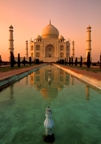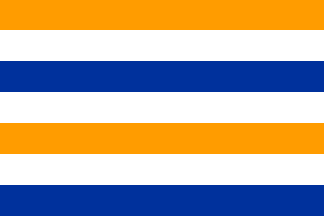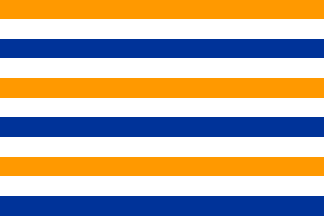

THE WORLD : OCEANIA

 |
THE WORLD : OCEANIA |
 |
The World in 2000 | Africa | Central America And The Caribbean | North America | South America | Antarctica
Central Asia | Eastern And South-Eastern Asia | South Asia | Europe | The Middle East | Oceania
Timeline | Differences | Politics | Science and Technology | Society | Notes | Summary | Home
This page is divided into the following sections:
Click on the section names to return to the top of the page.
Note that in this world the island continent of Australia is known as Marege. This is the name for the north coast of Australia used by fishermen from Makassar for hundreds of years. Because of the increased Asian focus of this world this name has come into general use across Gurkani Âlam as the accepted name for the entire continent.
The French colony on the east coast of the island continent of Marege [Australia], it is part of France-Outre-Mer. Most of the income of France Australis comes from agriculture, with a significant wine-making industry forming part of this. However, there is also a significant mining industry which also provides income.
The capital of France Australis is the city of Nouveau Paris [New Paris; Sydney].
Although much of the economy of France Australis is tied into that of the rest of the French Empire, it is also heavily dependant of trade with the Dakshina Nad and to a lesser extent the Mughal Empire.
The Mughal Subah (province) on the island continent of Marege. It is a large territory but one with an uninviting climate and, since the handing over of the mineral-rich western portion of the Subah to Ayutthaya in 1978 in return for their continuing effort in the Long War, a place with few natural resources. Because of this Koshiki has a very low population density with what people do live there being mainly farmers, along with a few miners and military personnel. Most of the population of Koshiki are native Maregians [Australian aborigines]. There is a fairly large transient population of military personnel who use the wide open spaces of Koshiki for training purposes.
Its capital is the city of Lortzingabad [Derby, Western Australia of the real world].
The Scottish colony on the island continent of Marege. Located on the south-eastern tip of Marege [at Cape Howe] it is entirely surrounded by the French colony of France Australis. Although New Argyll is technically only the name of the capital city, the name is in general use for the place as a whole. Although the colony does possess some oil resources, and provides Scotland with a military presence in Marege, in general New Argyll is kept as a prestige colony.
The Anglo-Danish colony on the island continent of Marege.
A Dominion of the Anglo-Danish Empire, it is ruled by a President from its capital city of New Dublin [Cairns, Queensland], aided by an Advisory Council. Much of its economy is based on mining and the growing of sugar cane [much like the Australian state of Queensland in the real world, and for much the same reasons].
As the most distant and isolated of all of the Anglo-Danish colonies it originated as a penal colony and has long been used as a place of exile and as a dumping ground for undesirables of all kinds. In addition to this, its position has required it to be well-defended. During most of the Long War it existed in a state of siege within a much reduced territory, attacked by French and Indian Alliance forces and thrown back on its own resources and wits for decades. As such it declared itself neutral and pulled out of the Long War for its own survival considerably before the rest of the Anglo-Danish Empire, despite the best efforts of the Anglo-Danish government to prevent this.
Unlike the other dominions of the Anglo-Danish Empire, most of the industry and utilities of Nova Hibernia do not form part of the Great Three companies. Although this was not the case before the Long War, during the war the isolation of the dominion led to many changes which essentially eliminated the presence of the companies there.
With the end of the Long War Nova Hibernia has remained at its reduced size, its new ruler-straight borders defined by treaty. It has also lost the islands of New Wight and Easter Island [Vanuatu and New Caledonia respectively]. The re-opening of free contact with the rest of the Anglo-Danish Empire has made it very clear that significant differences between Nova Hibernia and the rest of the Anglo-Danish Empire have developed over the years of separation. For this reason there are many in Nova Hibernia who advocate secession from the Anglo-Danish Empire, with Nova Hibernia becoming a free nation in its own right, and despite efforts to suppress it by the Anglo-Danish government, support for the movement is growing among the self-sufficient and heavily-armed populace.
The people of Nova Hibernia are more than a little xenophobic of outsiders, and gun ownership is widespread among the populace. With the growing independence movement this is at least as much as a protection against the Anglo-Danish government as against foreign invasion.
One of the two Dutch-descended colonies on the island continent of Marege, located on its northern coast [roughly equivalent to Arnhem Land of the real world]. Its economy is based largely on mining of the rich mineral resources it contains, particularly bauxite, uranium, manganese and iron ore, which it supplies to customers around the world.
Although economically open to all of the nations of the world, politically and militarily Nova Holland remains a xenophobic, closed, insular society, run in the most part along strict Calvinist lines. Nova Holland as a whole is suspicious of the outside world and non-Calvinist Protestant Christians in particular (in part due to their surrounded by non-Christian nations), but not above taking their money. The people of Nova Holland and regimented and quite militarised, with the ownership of guns being very widespread and military service mandatory for all citizens of both genders for two years from the age of eighteen, and training throughout the rest of their lives. Despite this it is closely allied with Van Diemens Land off the southern coast of Marege.
Because of their xenophobic treatment of the Maregian natives [Australian aborigines] who lived in the area that became Nova Holland, very few of them remain there in the present day.
The currency of Nova Holland is the Gulden [Guilder], as in the Netherlands before they were taken over. This is divided into 20 Stuivers, each of 8 Duit or 16 Penning. Other units of currency include the Daalder of one and a half Gulden (30 Stuivers) and the Rijksdaalder of two and a half Gulden (50 Stuivers). The Nova Holland Gulden is not the same as those of Oranjestaat or Van Diemens Land, and does not have the same value as either of them.
The capital of Nova Holland is the city of Calvinstad [Calvin's Town; Darwin of the real world], although before the independence of Nova Holland this was known as Nieuw Rotterdam [New Rotterdam].
The flag of Nova Holland has seven horizontal stripes forming a double tricolour of orange, white and blue separated by an additional white stripe. This is known as the Double Princevlag (Princes flag), identical to a version of the Netherlands flag that was sometimes used in the past.

The Mughal Subah (province) centred on the islands of Flores, Sumba and Timor, but also extending as far east as the island of Yamdena [all part of real world Indonesia]. Sawu was acquired by the Mughal Empire in the chaos following the eruption of the volcano of Krakatau in 1883 and despite protests at the time it has kept control of the islands ever since. The region was incorporated into a subah in 1908.
The Scottish colony made up of the southern island of the New Zeeland islands, Scotia Australis is often considered to be more Scottish than Scotland itself. This is because it was largely settled by Scots who considered that the 'true' Scotland was being corrupted by the influx of immigrants and foreigners since the end of the War of the English Succession. As such Scotia Australis is run very much along the lines of the old Highland clan system, though with some modifications to account for the modern world. After a number of conflicts between the Europeans and natives of Scotia Australis the tribes of the Maori people of Scotia Australis have been given the status of honorary clans, and operate within the political system in the same way as them.
The economy of Scotia Australis is based largely on agriculture, particularly the raising of cattle and sheep, although there is some mining and generation of hydroelectricity, as well as a significant fishing industry.
The capital of Scotia Australis is the city of Nova Dunedin [Christchurch of the real world].
The colony of the Kingdom of Ayutthaya on the island continent of Marege, it was purchased from the Mughal Empire during the Long War in 1978 for a nominal price, as part of an agreement that kept Ayutthaya in the war.
Since then Ayutthaya has benefited financially from the income it now obtains from the rich mineral resources of the region.
The Mughal influence in the region is still obvious from the architecture and place names of the area, and there is still a good deal of bad feeling and unrest in Ayutthayan Marege over the selling of the region to Ayutthaya, with some emigration to Koshiki or elsewhere in the Mughal Empire, and, since the end of the Long War, attempts to have the region returned to the Mughal Empire.
Its capital is the city of New Ayutthaya, formerly known by its Mughal name of Hopkinsabad [Port Hedland of the real world].
The French colony made up of the northern island of the New Zeeland islands, named after the French King who ruled at the time of its being claimed, Terra Henri is part of France-Outre-Mer. Because of the clement climate of Terre Henri the island has a culture and look very similar to that of the south of France, and many French people aspire to go there to live or retire.
In Terre Henri the native Maori people are largely assimilated into the French population, although they retain their own language and belief systems, as well as, in many cases, their distinctive facial tattooing. Many Maoris who disagreed with this assimilation emigrated to Scotia Australis to join the more traditional life lived by the Maori there.
Most of the income of Terre Henri comes from agriculture, with a significant wine-making industry forming part of this. Fishing and forestry also generate significant income.
The capital of Terre Henri is the city of Ville d'Henri [Henrystown; Auckland of the real world].
One of the two Dutch-descended colonies on the island continent of Marege, located on the island which in the real world is known as Tasmania. Its capital is the city of Nieuw Leiden [New Leiden; Devonport, Tasmania]. Its economy is based on mining and agriculture.
Van Diemens Land [Tasmania] is a conservative, rather regimented society which remains rather closed from the outside world. Gun ownership is very widespread and military service mandatory for all citizens of both genders for two years from the age of eighteen, with additional training throughout the rest of their lives. However, Van Diemens Land is also a Vrijdenkerij [atheist] state and nowhere near as xenophobic and insular as Nova Holland, and so a place which remains fairly open to the outside world. Despite this it is closely allied with Nova Holland.
Another side effect of this is that significant numbers the original Maregian natives [Tasmanian aborigines] who lived in the area that became Van Diemens Land still live there to this day, albeit as a small minority of the population [unlike the case in the real world].
The currency of Van Diemens Land is the Gulden [Guilder], as in the Netherlands before they were taken over. This is divided into 20 stuivers, each of 8 duit or 16 penning. Other units of currency include the daalder of one and a half gulden (30 stuivers) and the rijksdaalder of two and a half gulden (50 stuivers). The Van Diemens Land Gulden is not the same as those of Oranjestaat or Nova Holland, and does not have the same value as either of them.
The flag of Van Diemens Land has eleven horizontal stripes forming a triple tricolour of orange, white and blue with each tricolour separated by an additional white stripe. This is known as the Triple Princevlag (Princes flag), identical to a version of the Netherlands flag that was sometimes used in the past.

The World in 2000 | Africa | Central America And The Caribbean | North America | South America | Antarctica
Central Asia | Eastern And South-Eastern Asia | South Asia | Europe | The Middle East | Oceania
Go to the Gurkani Âlam Timeline, Differences, Politics, Science and Technology, Society, Notes or Summary Pages.
Back to the Gurkani Âlam Home Page.
 |
Copyright © Tony Jones, 2007.
This work is licensed under a Creative Commons Attribution-Noncommercial-Share Alike 3.0 License. |